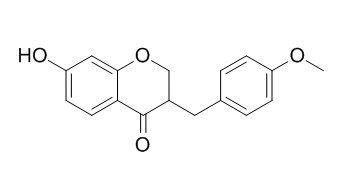Dihydrobonducellin
Dihydrobonducellin has immunopharmacological activity, it significantly inhibits the production of IL-2 and IFN-gamma in activated PBMC in a concentration-dependent manner.
Inquire / Order:
manager@chemfaces.com
Technical Inquiries:
service@chemfaces.com
Tel:
+86-27-84237783
Fax:
+86-27-84254680
Address:
1 Building, No. 83, CheCheng Rd., Wuhan Economic and Technological Development Zone, Wuhan, Hubei 430056, PRC
Providing storage is as stated on the product vial and the vial is kept tightly sealed, the product can be stored for up to
24 months(2-8C).
Wherever possible, you should prepare and use solutions on the same day. However, if you need to make up stock solutions in advance, we recommend that you store the solution as aliquots in tightly sealed vials at -20C. Generally, these will be useable for up to two weeks. Before use, and prior to opening the vial we recommend that you allow your product to equilibrate to room temperature for at least 1 hour.
Need more advice on solubility, usage and handling? Please email to: service@chemfaces.com
The packaging of the product may have turned upside down during transportation, resulting in the natural compounds adhering to the neck or cap of the vial. take the vial out of its packaging and gently shake to let the compounds fall to the bottom of the vial. for liquid products, centrifuge at 200-500 RPM to gather the liquid at the bottom of the vial. try to avoid loss or contamination during handling.
BMC Complement Altern Med.2014, 14:242
Int J Mol Med.2020, 45(5):1514-1524.
J Appl Biol Chem.2024, 67:39,281-288.
Int J Mol Sci.2021, 22(21):11447.
Prev Nutr Food Sci.2024, 29(4):504-511.
Applied Biological Chemistry2023, 66:85.
Agronomy2023, 13(9), 2410.
Pharmacogn Mag.2015, 11:S585-91
Preprints2022, 202211.0388.v1.
Korean Journal of Pharmacognosy.2019, 50(1):65-71
Related and Featured Products
Molecules. 2009 May 12;14(5):1789-95.
Isolation and immunomodulatory effect of homoisoflavones and flavones from Agave sisalana Perrine ex Engelm.[Pubmed:
19471199]
METHODS AND RESULTS:
Three known flavones and seven known homoisoflavonoids were isolated from the methanolic extract of the leaves of Agave sisalanaPerrine ex Engelm. Their structures were elucidated on the basis of spectroscopic analysis. The isolated compounds were also evaluated for immunopharmacological activity. PBMC were used as target cells, and cell proliferation was determined by (3)H-thymidine uptake. (+/-)-3,9-Dihydroeucomin (4), Dihydrobonducellin (5), and 5,7-dihydroxy-3-(4'-hydroxybenzyl)-4-chromanone (7) showed inhibitory effects on PBMC proliferation activated by PHA with IC(50) values 19.4, 73.8, and 58.8 microM, respectively.
CONCLUSIONS:
All three compounds significantly inhibited the production of IL-2 and IFN-gamma in activated PBMC in a concentration-dependent manner.
Phytochemistry. 2004 Sep;65(17):2455-61.
Stimulating the production of homoisoflavonoids in cell suspension cultures of Caesalpinia pulcherrima using cork tissue.[Pubmed:
15381409 ]
It has previously been demonstrated that cork tissue increases the efficiency of the production of lipophilic secondary metabolites in diverse plant cell suspension cultures.
METHODS AND RESULTS:
In the present study, three new homoisoflavonoids--named Dihydrobonducellin, 2'-methoxyDihydrobonducellin, and 2'-methoxybonducellin--and bonducellin and isobonducellin were isolated from Caesalpinia pulcherrima cultured cells coincubated with cork tissue. Cork tissue increased the production of 2'-methoxybonducellin by about 7-fold relative to control cells, and more than 80% of the product was recoverable from the cork tissue. When cork tissue and methyl jasmonate or yeast extract were added simultaneously to the medium, the amount of 2'-methoxybonducellin produced increased further. The production of the other four homoisoflavonoids was enhanced by variable amounts.
CONCLUSIONS:
Our results indicate that the addition of cork tissue would be an effective technique for investigating formation of secondary metabolites that usually accumulate only in trace amounts.
Secologanic acid
Catalog No: CFN95028
CAS No: 60077-46-5
Price: $318/20mg
Parvisoflavanone
Catalog No: CFN95077
CAS No: 49776-79-6
Price: $413/5mg
1,3,6-Trihydroxy-2-methylanthraquinone 3-O-alpha-L-rhamnosyl-(1->2)-beta-D-glucoside
Catalog No: CFN95096
CAS No: 87686-88-2
Price: $318/10mg
New compound 2
Catalog No: CFN95181
CAS No: N/A
Price: $318/5mg
5,6,7,3',4'-Pentamethoxyflavanone
Catalog No: CFN95394
CAS No: 104193-93-3
Price: $318/5mg
(Z)-3,11-dimethy-7-methylene-9,14-epoxy-1,6,10-dodecatrien-3-ol
Catalog No: CFN95402
CAS No: 1392202-57-1
Price: $318/10mg
Tetillapyrone
Catalog No: CFN95404
CAS No: 363136-43-0
Price: $413/5mg
Oxytroflavoside E
Catalog No: CFN95464
CAS No: 1391144-84-5
Price: $318/5mg
Quercetin-3-O-[alpha-L-rhamnose-(1->2)-beta-D-glucopyranosyl]-5-O-beta-D-glucopyranoside
Catalog No: CFN95506
CAS No: 1309795-36-5
Price: $318/5mg
8-Hydroxy-5,7-dimethoxyflavanone
Catalog No: CFN95580
CAS No: 201230-40-2
Price: $318/5mg



